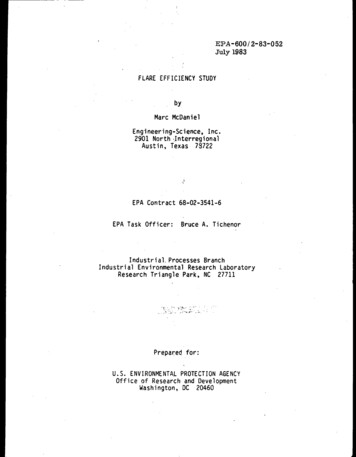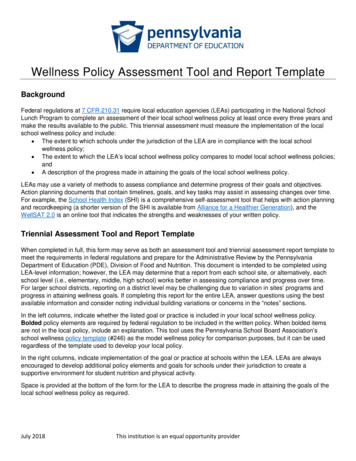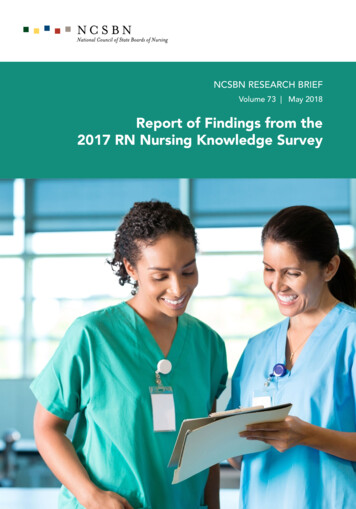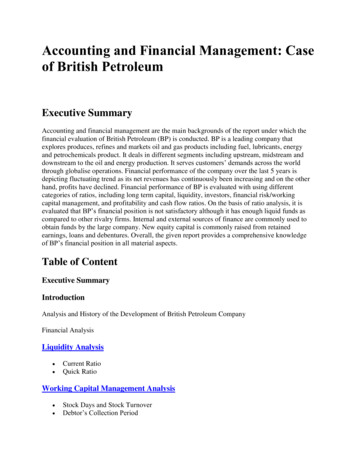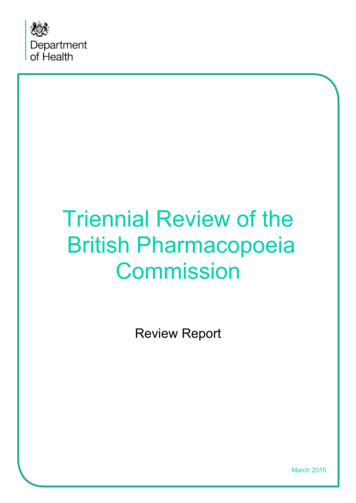
Transcription
Triennial Review of theBritish PharmacopoeiaCommissionReview ReportMarch 2015
Title: Triennial Review of the British Pharmacopoeia Commission – Review ReportAuthor: Jamie Grant, Lead Reviewer – BPC, Assurance Division, Group Operations (17152)Document Purpose: Corporate ReportPublication date: 26 March 2015Target audience: GPs, Pharmacists, Regulatory body, Academic/ Professional institution,Royal Colleges, General public, Suppliers.Contact details:Triennial Review Programme TeamDepartment of Health220 Richmond HouseLondonSW1A 2NSTR-BPC@dh.gsi.gov.ukYou may re-use the text of this document (not including logos) free of charge in any format ormedium, under the terms of the Open Government Licence. To view this licence, nt-licence/ Crown copyrightPublished to gov.uk, in PDF format only.www.gov.uk/dh2
Triennial Review of theBritish PharmacopoeiaCommissionReview Report3
ContentsContents. 4Executive summary . 5Acknowledgements . 81.Introduction . 92.The Review: Stage One . 143.Conclusions of Stage One . 244.The Review: Stage Two . 255.Conclusions of Stage Two . 37Annex A: Compliance with the Principles of Good Corporate Governance . 39Annex B: International Comparison . 46Annex C: Performance . 47Annex D: List of Stakeholders Consulted . 49Annex E: Review Governance . 494
Executive summaryThe Department of Health’s (DH) Triennial Review of the British Pharmacopoeia Commission(BPC) was conducted to provide assurance to the Department and the public that the BPC’sfunctions are required and that it is operating effectively. This review forms one of a series ofreviews being conducted by the DH between 2014-15 and 2016-17 of all of its arm’s lengthbodies and Special Health Authorities. The review of the BPC was announced by WrittenMinisterial Statement on 30 October 2014.Stage One of the review examined the functions and form of the BPC. The BPC has three mainfunctions which together perform a role protecting public health of UK and European citizens byestablishing public standards for pharmaceuticals. The evidence suggested these are stillrequired, and that the optimal form for the BPC is in a position close to the Medicines andHealthcare Products Regulatory Agency whilst being independent of it. The Advisory NonDepartmental (Advisory NDPB) model facilitates this, as well as enabling the BPC to harnesspotential information, communication, laboratory and expertise synergies.Stage Two of the review examined the efficiency, governance and performance of the BPC. Theevidence suggested that the BPC operates efficiently, is mostly compliant with the principles ofgood corporate governance and is considered to be a leading global pharmacopoeia. Inparticular, stakeholders highlighted the BPC’s innovative work, the dedication and expertise ofmembers and the Secretariat, industry engagement and transparency.The key concern emerging from the review relates to the number of appointment terms due tofinish at the end of the year, which will result in a significant loss of experience and expertise.The report also makes a number of minor recommendations summarised on the next page.5
Stage One: Function and FormRecommendation 1: the BPC should continue to deliver its existing functions as an AdvisoryNDPB.Stage Two: Efficiency, Governance and PerformanceContract managementRecommendation 2: in order to deliver best value, the BPC Secretariat and the Agency shouldensure they generate as much competitive interest in tendering as possible during the nextexercise, and that the appropriate support or advice is sought from the Crown CommercialService.Recommendation 3: in addition to managing a competitive tendering process as referred to inRecommendation 2, within the lifetime of the next contract the Secretariat should explore thefeasibility of bringing the digital element of the BP in-house (consulting the Government DigitalService as appropriate).Commission/Secretariat relationshipRecommendation 4: the BPC Chair should be formally consulted as part of individualSecretariat staff appraisals, with the views of other members of the BPC to be s ought asappropriate.Recommendation 5: The BPC Secretariat should consult the BPC Chair/Vice-Chair regardingstrategic and financial considerations impacting the BPC, and together determine the degree ofdetail relevant for consideration by Commission members to inform their input.Commission member appointmentsRecommendation 6: BPC Secretariat and the DH Appointments Team should meet postelection to agree an appropriate model for future appointments. Ahead of this the BPC shouldgather data on the pool of qualified people being targeted. [Key Recommendation]Recommendation 7: appointment term end dates should be clustered into small groupsacross a spread of years to ensure continuity of service.Recommendation 8: the BPC and Secretariat should consider draft monograph publication to aspecific predictable timetable, including a deadline for comments.Recommendation 9: the Secretariat should ensure the redeveloped website explains the workand procedures of the BPC more effectively, for example by making the terms of reference,expenses policy, appointments procedures and a list of members of the Commission and itssupporting groups publically available.6
Recommendation 10: the Secretariat should ensure the redeveloped website is used to helpbuild a list of interested people to be approached during Commission recruitment campaigns orto fill Expert Advisory Group vacancies.Recommendation 11: the BPC Secretariat should work with the department to establish aprocess whereby the Chief Medical Officer writes to Commissioners’ employers on appointmentor reappointment, highlighting the importance of their work and the value such experienceprovides.7
AcknowledgementsThe review team would like to thank members of the BPC and the Secretariat for their constructiveengagement throughout the review process, as well as the stakeholders who were interviewed orsubmitted responses to the online Call for Evidence.8
1. IntroductionAims of the Review1.1 It is Government policy that a Non-Departmental Public Body (NDPB) should only be setup, or remain in existence, where the model can be clearly evidenced as the mostappropriate and cost-effective way of delivering the functions in question.1.2 In April 2011, the Cabinet Office announced that all NDPBs still in existence following theGovernment’s review of public bodies in 2010 would have to undergo a substantive reviewonce in a three year cycle. Triennial Reviews have two principal aims, represented by twostages:1. To provide a robust challenge of the continuing need for individual NDPBs – both theirfunctions and their form; and2. Where it is agreed that a body remain as an NDPB, to review:a. its capacity for delivering more effectively and e fficiently, including identifyingpotential for efficiency savings and i ts ability to contribute to economic growth;andb. the control and governance arrangements in place to ensure that the publicbody and the sponsoring department are complying with recognised principles ofgood corporate governance. This should also include an assessment of thebody’s performance.1.3 Following the health and social care system reforms, set out in the Health and Social CareAct 2012 and the Care Act 2014, functions and powers were devolved away from theDepartment of Health (DH) to arm’s length bodies and local health and care organisations.As steward of this evolving system, the DH has extended the Triennial Reviewsprogramme to all of its arm’s length bodies and Special Health Authorities to provideassurance that the system, and the new and reformed bodies within it, are fit for purposeand operating effectively. The review of the British Pharmacopoeia Commission (BPC), anAdvisory NDPB of the Department, was scheduled for 2014/15.Review Principles1.4 All Triennial Reviews are carried out in line with Cabinet Office guidance “Guidance onReviews of Non-Departmental Public Bodies”, revised in 2014. This guidance states thatall reviews should be conducted in line with the following principles:Challenge: Reviews should take a f irst principles approach to whether the function of abody is still needed and, if so, what then is the best form for delivery of that function.Reviews should consider efficiency and performance.Proportionality: Reviews must not be overly bureaucratic and should be appropriate for thesize and n ature of the NDPB. Where appropriate, reviews of similar bodies should be9
combined or clustered to ensure the maximum benefit in terms of streamlining the reviewprocess, identifying synergies across departments and NDPBs, and considering efficiency.Contextual: Reviews should not be undertaken in silos, but should wherever possible beintegrated with other departmental policy initiatives.Pace: Reviews must be c ompleted quickly to minimise disruption to the business andreduce uncertainty about the NDPB’s future.Inclusivity: Reviews must be open and inclusive. The NDPB being reviewed must beengaged in reviews. Users and stakeholders should have the opportunity to contribute toreviews. Parliament should be informed about the commencement and conclusions ofreviews. Departmental Select Committees must be given the opportunity to input.Transparency: All reviews must be ann ounced formally, both to Parliament and to thepublic. All review reports must be published once clearance has been given by the Ministerfor the Cabinet Office. The results of reviews must be announced to Parliament.Process1.5 The review was conducted by the DH Triennial Review Team. The start of the review wasannounced by Written Ministerial Statement to both Houses of Parliament on 30 October2014 in tandem with the reviews of the Medicines and Healthcare Products RegulatoryAgency (‘the Agency’), the National Institute for Heath and Care Excellence (NICE), theCommission on Human Medicines (CHM), the Administration of Radioactive SubstancesAdvisory Committee (ARSAC) and the Independent Reconfiguration Panel (IRP).1.6 In accordance with Cabinet Office guidance that Triennial Reviews should beproportionate to the size of the body, the BPC review followed a ‘light touch’ approach withevidence gathered simultaneously for both stages of the review. It was agreed with theCabinet Office to ‘cluster’ the governance arrangements with the parallel reviews of theCHM, another Advisory NDPB of the DH, and the Agency, an Executive Agency of the DH,which oversees and supports both the BPC and the CHM.1.7 The three reviews were overseen by a DH director-level Senior Review Sponsor (SRS). AProject Board made up of the Agency’s Chief Operating Officer, the Agency’s Director ofPolicy, a DH Sponsor Team representative and a member of the Triennial Review Teamwas chaired by the SRS, and was responsible for holding the review team to account andensuring the final report is balanced and evidence-based.1.8 In line with Cabinet Office guidance, for the larger reviews of the Agency and NICE aChallenge Group was formed to test and c hallenge the assumptions and c onclusions ofthe review. As the reviews were clustered, the BPC Scoping Document (including KeyLines of Enquiry) and emerging findings were put to the group for comment and approval.10
1.9 Additionally, a T riennial Review Steering Group chaired by the Director of the DHAssurance Division oversaw the wider review programme of work.1.10 The Terms of Reference, membership of the Challenge Group and the Written MinisterialStatement announcing the review can be found in Annex E.Evidence and Stakeholder Engagement1.11 A joint Stakeholder Engagement Strategy was produced for the reviews of the BPC, theCHM and the Agency. Extensive input was provided from the bodies under review, and thedocument was approved by the Project Board and Challenge Group.1.12 Evidence was gathered through a v ariety of means including desk-based research,submitted evidence, interviews with key stakeholders and a pu blic Call for Evidence.Stakeholder engagement is summarised in Annex D.1.13 The review was announced by Written Ministerial Statement and ministers wrote to theHealth Select Committee to inform them of the review.Background on the BPC1.14 The BPC, appointed under Part 2 o f the Human Medicines Regulations 2012, is anAdvisory NDPB of the DH. The BPC has three formal functions:i.preparing new editions of the British Pharmacopoeia (BP) and the BritishPharmacopoeia (Veterinary) and for keeping them up to date under regulation 317 ofthe 2012 Regulations. The BP is a publication (both print and electronic) of publiclyavailable standards for active pharmaceutical ingredients and finished dosage formsof pharmaceutical products. Where a monograph 1 exists, it is a l egal standard formanufacturers to follow when requesting marketing authorisation for their products;ii.providing advice to the United Kingdom delegation to the European PharmacopoeiaCommission (Ph. Eur. Commission), of which the United Kingdom is a member byvirtue of its obligations under the Convention on the Elaboration of a EuropeanPharmacopoeia; and1A monograph includes the name of the ingredient or preparation, the Definition, a series of tests, procedures forthe tests, acceptance criteria and storage and labelling requirements where necessary. These tests andprocedures often require the use of official Chemical Reference Substances such as the BP Chemical ReferenceSubstance.11
iii.selecting or devising names to be used at the head of monographs, which aresubsequently published as British Approved Names (BANs), under regulation 318(2)of the 2012 Regulations.Historical Context1.15 The BP was formed from the merger of the London, Edinburgh and DublinPharmacopoeias in 1864. Between 1864 and 1971 the BP was produced by the GeneralMedical Council. With the implementation of the 1968 Medicines Act, the publicationbecame the responsibility of the BPC, a Section 4 Committee under the Act, whichpublished the BP on behalf of Health Ministers. With the implementation of the Act the BPstaff became a part of the DH.1.16 The 1987 Cunnliffe report, which led to the formation of the Medicines Control Agency(MCA) as the UK Licensing Authority, recommended that the BP should be transferred tothe Royal Pharmaceutical Society but this was rejected. With the formation of the MCA in1989, the Secretary and Scientific Director and t he BP Laboratory Director becameemployees of the MCA but all other costs were met by the DH.1.17 In 1999, DH commissioned Roy Cunningham to review the role and operation of the BPC.It was agreed that the BP publication should continue but that the DH would no longer fundit. In 2003, with the merger of the MCA and Medical Devices Agency (MDA) to form theMedicines and Healthcare Products Regulatory Agency, the BP became a part of thetrading fund and thus a business unit of the Agency. A business case showing that the BPwould operate as a self-sufficient unit was agreed with HM Treasury. The BP was requiredto cover the costs and expenses of the BPC and its committees, the BP Secretariat at theAgency, the BP Laboratory and the expenses and fees of UK members of Ph. Eur. Groupsof Experts from the income it generated from the royalties on the sale of the publication,and from the sales of BP chemical reference substances (BPCRS).1.18 The Government undertook a review of public bodies and functions in 2010,encompassing more than 900 public bodies across 17 depar tments. It was decided thatthe BPC should continue as an Advisory NDPB.1.19 In 2011, the then BP Secretary & Scientific Director reviewed the BP’s national andinternational role, concluding that that it was a valuable international asset and there wasstrong evidence to support a ten-year publication programme for the BP.12
Structure1.20 The BPC has 17 members appointed by Ministers and meets 3 times a year. The work ofthe BPC is supported by 9 Expert Advisory Groups2 (EAGs), 6 Panels of Experts3 and 2Working Parties 4 collectively comprising approximately 100 experts and meeting sixteentimes in 2014.1.21 The Commission undertakes the key work of the organisation, it does not simply provideoversight, as is the case for other types of public bodies. Scientific advisory bodies oftenneed larger boards in order to cover the range of expertise necessary to perform the workeffectively.1.22 The annual spend of the Commission, comprising attendance fees, travel & expenses andhospitality, is approximately 60,000.1.23 The BPC Secretariat (‘the Secretariat’) is part of the Inspection, Enforcement andStandards Division of the Agency.2Under regulation 14 of Part 2 of the 2012 Regulations, an advisory body may, with the approval of the LicensingAuthority (the Agency), appoint one or more sub-committees, or the Licensing Authority may direct an advisorybody to appoint an EAG to advise on specific matters. They are chaired by a member of the BPC.3The remit of the Panels mainly covers European Pharmacopoeia specifications and advice is normally sought bycorrespondence.4There are currently two Working Parties advising the BPC on excipients and Analytical Quality by Design.Working Parties are normally formed on an ad hoc basis to cover particular areas of interest and provide specialistadvice.13
2. The Review: Stage One2.1 Stage One of the review addresses two fundamental questions: do the functions providedby the BPC still need to be performed; and if they do, what is the appropriate deliverymodel for those functions?Functions2.2 The BPC provides three main functions: producing and updating the BP, providing adviceto the UK Delegation to the Ph. Eur. Commission and selecting or devising BANs.The BP2.3 The BP is published annually in August, with an effective date of 1 January the followingyear. It is available as a package containing the six volumes currently comprising the BP2015, the one volume of the British Pharmacopoeia (Veterinary) 2015 and access to theelectronic versions of both publications (online and single-user USB format). It containsalmost 3500 monographs for substances and articles used in the practice of medicine 5and over 400 i nfrared reference spectra 6, together with appendices and supportingmaterial.2.4 Article 63(1) of the 1973 European Patent Convention specifies the term of a Europeanpatent to be 20 years from the date of filing of the application and article 63(2b) allows foran extension under national law to compensate for pre-marketing regulatory approval.Once the patent term of a drug expires, the drug loses its legal protection and can besynthesised as a generic medicine. Any manufacturer is then free to apply for a marketingauthorisation. Generic drugs comprised 22% of the UK medicines in 2011, and this isexpected to increase to 27% by 2020. 72.5 The work of the BPC is to create monographs for medicinal substances either off, orcoming-off patent, or to revise existing monographs reflecting new methodologies,processes or in response to problems. Inclusion of monographs in the BP creates a legallybinding, up-to-date set of minimum standards, which ensure the safety and quality ofmedicines available in the UK.5Monographs exist for active substances, excipients (pharmacologically inert ingredients used in medicines) andfinished products.6Used to identify medicinal substances.7PwC (2012) ‘From vision to decision Pharma 2020’ (available online).14
Advice to the European Delegation2.6 The European Pharmacopoeia Convention was established in 1964 to create harmonisedEuropean standards for medicinal substances. The Ph. Eur. Commission, which developsthe European Pharmacopoeia (Ph. Eur.), is formed of delegations from the 37 signatoryMember States.2.7 Further to the UK delegation on the Ph. Eur. Commission, a number of BPC and EAGmembers participate in the Groups of Experts and Working Parties.2.8 The BP Laboratory provides technical support for the work of the Ph. Eur. Commission,participating in the voluntary scheme to validate draft European monographs and providingtechnical data in support of the elaboration of new monographs and revision of existingmonographs.BANs2.9 The third responsibility of the BPC is to select or devise names to be used at the head ofmonographs, which are subsequently published as BANs.2.10 A BAN is the official non-proprietary name (also known as a g eneric name) given to apharmaceutical substance for use in the UK (e.g. ‘paracetamol’ or ‘ibuprofen’). BANs areshort, distinctive names for substances where the systematic chemical or other scientificnames are too complex for convenient use 8. BANs are adopted where required for thosesubstances that are subject of a BP monograph and for products with a U K marketingauthorisation.2.11 The BANs are published every 5 y ears, with supplements issued annually at the sametime as the BP in August.International Collaboration and Harmonisation2.12 In addition to these three responsibilities, the BPC is involved in a range of internationalcollaboration and harmonisation activities. Harmonisation is the process of developingcommon methods, standards, monographs and good working practices across differentinternational jurisdictions. This activity includes formal collaboration through establishingMemoranda of Understanding with equivalent international bodies, informal collaborationand information sharing, supporting monograph development for the WHO InternationalPharmacopoeia and nomenclature work.8For example, the chemical name of paracetamol is ‘N-(4-Hydroxyphenyl)acetamide’.15
Assessment: are the functions still required?2.13 The BAN function fulfils a s tatutory requirement of the 2012 Human MedicinesRegulations. The evidence suggested that the function needs to be delivered to ensure aconsistent approach to the naming of pharmaceuticals in the UK. This implicitly supportspublic and professional confidence in medicines regulation.2.14 Assessment: BAN function is required.2.15 The function of providing advice to the UK Delegation to the Ph. Eur. Commission is aninternational legal requirement under the Convention on the Elaboration of a E uropeanPharmacopoeia.2.16 The Medicines Directive EU 2001/83 requires pharmaceutical products to comply with themonographs of the Ph. Eur. or, where no s uch monograph exists, that of a nationalpharmacopoeia. In other words when the European Pharmacopoeia publishes amonograph for a particular ingredient or finished product it replaces any pre-existingversion in the national pharmacopoeias of member states. Therefore the UK has a vestedinterest in ensuring that the output of the Ph. Eur. Commission is of a hi gh standard bycontributing a delegation of experts.2.17 Having a voice in those proceedings ensures decisions that are taken are in the interestsof UK industry and the public.2.18 Assessment: advice to the UK delegation of the Ph. Eur. Commission function isrequired.2.19 The processes of harmonisation at the European and global level have implications for theBP as a national pharmacopoeia. In particular, given the legal precedence of the Ph. Eur.monographs over the BP monographs described above, by supporting the elaboration ofthe Ph. Eur. the unique content in the BP diminishes. Taken to the extreme, the BP wouldeventually become obsolete if the Ph. Eur. expanded to include the same finished productmonographs.2.20 One of the key lines of enquiry of the 1999 Cunningham Review was to assess whetherthere was still a r ole for the BP given the continuing development of the Ph. Eur,concluding that finished product monographs were unlikely to form part of the Ph. Eur. inthe foreseeable future. By the time of the next review of the BP in 2011, the Ph. Eur. stillhad no mandate or programme to elaborate monographs for finished products.2.21 The European Medicines Agency (EMA) was established on the 26 January 1995,introducing the Centralised Product 9 authorisation procedure for human and veterinary9This procedure results in a single marketing authorisation that is valid in all EU countries, as well as in theEuropean Economic Area (EEA) countries Iceland, Liechtenstein and Norway.16
medicines. As described, patent terms are typically twenty years which means thoseproducts marketed through the European procedure are reaching the stage when genericversions can be developed.2.22 Recently the Ph. Eur. made the decision to extend its remit of publishing drug substancemonographs to drug product monographs and has instigated a Working Party to elaboratemonographs on finished dosage forms The current proposal is to publish a limited numberof finished product monographs.2.23 Since one of the BP’s strength lies in its set of finished product monographs, this raisesthe question that if the Ph. Eur. remit extends to tackling all finished products it couldpotentially obviate the need for the BP. The issue can be separated out into implicationsfor medicinal products newly coming off patent, and those for which the patent term hasalready expired.2.24 For products coming off patent, a nu mber of stakeholders questioned the Ph. Eur.’scapacity to take on preparation of finished product monographs. Following its decision toexpand into finished products, it had initially looked at developing monographs forestablished (off-patent) drugs, for which there are multiple manufacturers of finishedproducts. However, it has since decided to focus on drugs coming off patent, for whichthere is a single finished product manufacturer.2.25 Beyond this there is the subset of drugs which are off-patent but have no monograph yet.There are currently 600 monographs in the BP work programme (excluding revisions).Using the current average rate of 40 new monographs a year (see Annex C), this is 15years work even if the Ph. Eur. takes all products newly coming off patent.2.26 Even if the Ph. Eur. did have the capacity to develop finished product monographs for alldrugs coming off patent, and had begun to tackle preparations for existing off-patentdrugs, that still leaves the 1421 existing finished product monographs in the BP. Interviewssuggested that it was even more difficult to harmonise existing monographs than agreeingone for a new generic product. Harmonisation is difficult to achieve due to differences inlegislation, minimum standards, pharmacopoeial operations and resources. Largepharmaceutical companies and regulators would prefer harmonisation, but not at the costof relaxing standards to the lowest common denominator. There is a t rade-off betweenspeed of harmonisation and g etting the right approach. Additionally there are questionsaround the value of doing the work again.2.27 If the BP ceased to be published, the Ph. Eur. would provide standards for the majority ofpharmaceutical ingredients employed in medicines used in the UK. However, there wouldbe no published finished product monographs providing enforceable standards for thelarge majority of formulated medicines. This would impact on the UK and the other (mainlyCommonwealth) countries which have the BP as a legal standard. There was a range ofviews on how long it would take for harmonisation of finished product monographs with thePh. Eur. to significantly impact the work of the BPC, but most agreed it was likely to take adecade or more.17
2.28 Interviews also highlighted additional benefits of having a national pharmacopoeia. TheEuropean process is slower since it involves the 37 signatory states. Comments alsoreflected that there is national variation in what drugs are used: Germany and France forexample have a g reater focus on herbal and homoeopathic products than the UK. Anational pharmacopoeia enables prioritisation of standards which are more relevant to thatnation’s actual usage.2.29 Assessment: whilst there is uncertainty over the long-term future, the BP function isrequired in the medium term. Stopping the functions now would result in norecognised standards for the majority of finished pharmaceutical products.2.30 Finally, with regard to international collaboration and h armonisation a nu mber ofstakeholders doubted whether there would ever be a global, harmonised, pharmacopoeia.However, in the context of globalisation and an expansion in international trade, qualitystandards are a vital instrument for registration, market surveillance, and free movementand trade of medicines. While some stakeholders expressed doubts that harmonisationwill ever be achieved, it is an ambition that many would like to see happen and would helpto reduce costs in producing medicines, and therefore costs to purchasers. The BPC iswell placed to influence moves to further harmonisation throug
and operating effectively. The review of the British Pharmacopoeia Commission (BPC), an Advisory NDPB of the Department, was scheduled for 2014/15. Review Principles 1.4 All Triennial Reviews are carried out in line with Cabinet Office guidance “Guidance on Reviews of Non-Departmental P
